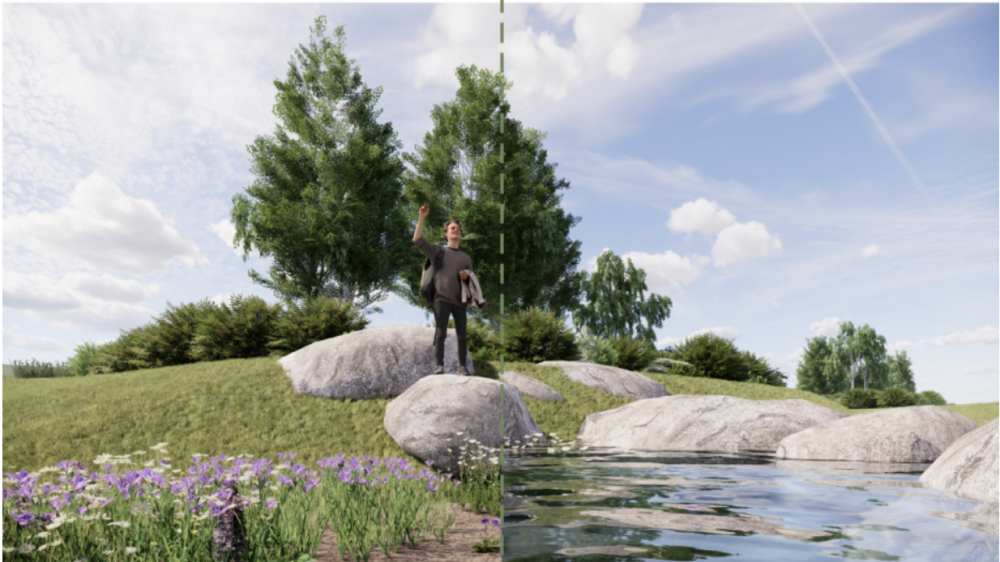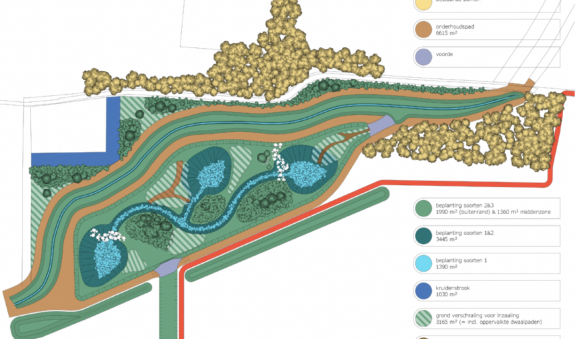Green show room of Business Centre Treeport

The Business Centre Treeport (BCT) site covers 54 hectares on the Dutch side. Of this, 12 hectares will be dedicated to green and nature areas, featuring elements such as wadis, trees, walking paths, perennials, and flower and herb mixes. One significant part of this development is the creation of a seed orchard, consisting of trees and plants that produce high-quality seeds for tree nurseries. The Agrobiodiversity work group from Coöperatieve Vereniging Treeport Zundert provides advice and guidance for this initiative.
The Agrobiodiversity work group includes members like tree nursery owner Jolanda van Hasselt and designer Joyce Oomen from BloomingBusiness. Given the numerous new business premises in and around Zundert, it was decided to have the green areas’ development overseen by this work group, with advice and plans focused on enhancing biodiversity. One of the work group’s pilot projects is the landscaping of the BCT site.
Safe traffic and green spaces
Remco van Dessel, project leader for the area’s development and member of the BCT team, explains: "We approach the design of public spaces functionally, determining what is needed for the business park to operate effectively. This includes planning the mobility routes for trucks, pedestrians, and cyclists. The remaining spaces are designated as green areas. Instead of hiring an urban planner, we chose to collaborate with the work group to create a showcase for the industry. Their proposals are evaluated by specialists in public space design, including ecologists, to ensure a balance between a functional business park and an optimal presentation of the industry."
The site’s landscaping has already begun. However, some parts will have to wait until major construction work is completed to ensure sustainable green development. Chantal van Kuyck, BCT’s general director, states: "We don’t want the greenery to suffer from on-going construction activities. We expect the landscaping to be completed in about two to three years."
“For the landscaping of BCT, we use the best of infrastructure and the best of green”
Seed orchard and green façades
Projects already underway or completed include the establishment of the seed orchard and a buffer strip along the water channels. Van Kuyck: “The first completed building, the DC Hazeldonk distribution centre, now features green façades with Hedera, Lonicera, jasmine, and Wisteria. Around the building, newly introduced plant varieties showcased at GrootGroenPlus have been planted, and planting under one of the wind turbines is also finished."
Van Hasselt, speaking on behalf of the Agrobiodiversity work group, says, "This site offers our tree nursery industry a unique opportunity to do things right from the start. We understand that some people want to see it green and lush quickly, but starting too early can lead to significant costs without optimal results. We can't afford to make mistakes. Planting will only begin when the soil conditions are right. One of our requirements was conducting a soil survey."
Van Hasselt aims for a natural look wherever possible. However, the plans for a green environment sometimes conflict with the functional requirements of the site. For example, planting trees with full canopies was not feasible due to truck traffic. “Joyce Oomen has developed fantastic plans that highlight the area's natural appearance, despite its function as a business park with large buildings. We have embedded green spaces into the zoning plan. Our decision to allocate so many hectares to nature instead of warehouses is, in my view, the best statement we can make. It needs to look spectacular, and I feel that this goes hand in hand with promoting biodiversity.”
“By greening 12 hectares at BCT, we create a show room for our industry”
Wider look
Oomen from BloomingBusiness is one of the 175 members of Treeport and established her company in Breda. She is also part of the Agrobiodiversity work group. "Most industrial areas look quite similar. We see an opportunity here to do something different and represent our industry at the same time. We share a common goal: to encourage the tree nursery industry to look at itself with a broader perspective beyond just their own products. This site will be a showroom for our products. We will demonstrate the beauty of combining different branches, such as trees, shrubs, grasses, and perennials. Native products are taken into account - maybe still limited, but they do play a part. As work group, we stand for biodiversity. In 2024, plants should not just be meant for people. As an industry, we have the opportunity to show that here, as a nice whole, in which three clusters flow into each other.” With clusters, Oomen - who is amongst other things responsible for the planting design in De Efteling - refers to trees, shrubs, and flowers. “In the selection of the trees, we take into account biodiversity. The design includes a robust green ‘cloud’ that connects the clusters along the main axis beautifully. This green cloud serves as a buffet for insects from the start to the end of the season. During the cold months, it provides excellent shelter as we avoid cutting back or tidying up the area. The colours of the flowers blend seamlessly and reappear along the main axis in repeating patterns. It creates a calm, elegant look with character. We are also integrating this into the outdoor space of the Rootz knowledge centre.”
A 2-hectare wadi
The landscaping is divided into six phases, including the main axis where trucks enter the site. It is designed so that in the future, trucks will enter a green environment. Additionally, a 2-hectare wadi will be developed. This area will be designed as a park-like environment, focusing on biodiversity and liveability. The site will be accessible to anyone wanting to enjoy a walk or bike ride. There will be a barefoot path for children and a picnic area, making it a worthwhile visit. "There will be no playground equipment," emphasizes Van Hasselt. "Only natural elements to enjoy yourself with." In selecting the varieties, the work group prioritises the added value for the area and ways to maximise biodiversity. At the same time, they strive to avoid a patchwork effect and maintain tranquillity in the designs. Van Hasselt: “To support the industry, we aim to use as much native material as possible. This is easier for shrubs than for trees, but we strive for as much natural growth as possible—though certainly some cultivars will be planted.”
For seeding, BCT chose two different mixes based on the advice of the work group: a Treeport mix and a Bee Landscape mix. The one-year Treeport mix was originally developed to encourage tree nurseries for sowing empty plots. Bijenlandschap West-Brabant encourages entrepreneurs to use perennial mixes along waterways, as these have a more significant positive impact on biodiversity. It is expected to take another two to three years for the full 12 hectares to be landscaped. BCT is a private entity, and the (green) development falls under the area’s development managed by Treeport BCT Partners BV. Once completed, the management and maintenance will be handed over to the Stichting Parkmanagement BCT.

.png)